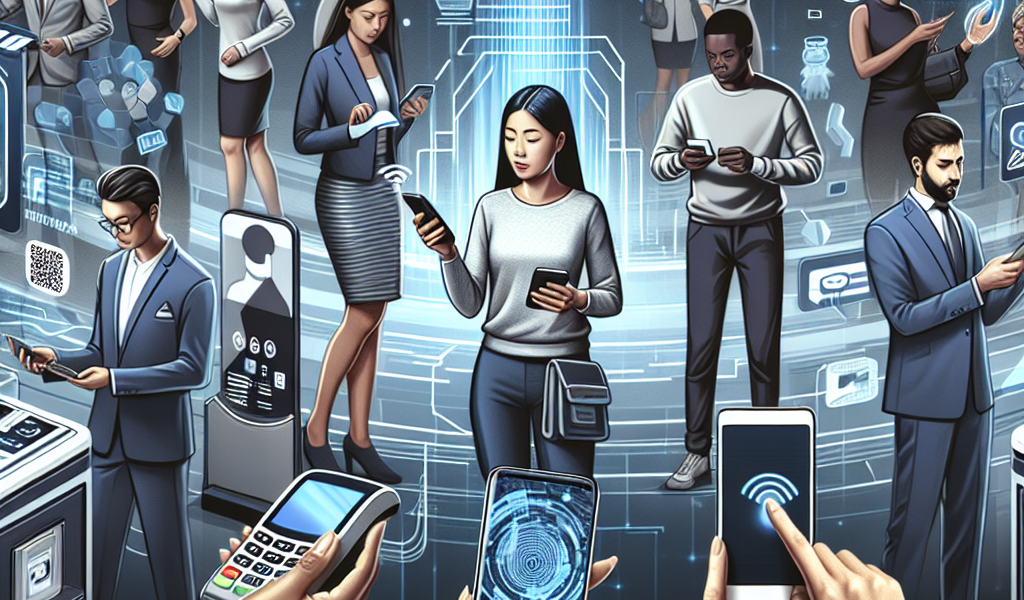-
Table of Contents
“Revolutionizing Transactions: The Future of Mobile Payments Unveiled”
Introduction

The future of mobile payments is poised for transformative growth, driven by rapid technological advancements and evolving consumer preferences. As smartphones become increasingly integral to daily life, the demand for seamless, secure, and efficient payment solutions continues to rise. Emerging trends such as biometric authentication, blockchain technology, and the integration of artificial intelligence are set to revolutionize the mobile payment landscape. Additionally, the proliferation of digital wallets, contactless payments, and the expansion of financial services in developing markets highlight the dynamic nature of this sector. Innovations in mobile payment systems promise to enhance user experience, bolster security, and expand financial inclusion, shaping a future where transactions are more convenient and accessible than ever before.
Cryptocurrency Integration in Mobile Payments
As the world continues to embrace digital transformation, the landscape of mobile payments is evolving at a rapid pace. One of the most intriguing developments in this space is the integration of cryptocurrency into mobile payment systems. This trend is not only reshaping how transactions are conducted but also opening up new possibilities for financial inclusion and security.
Cryptocurrency, once a niche interest for tech enthusiasts and early adopters, has now entered the mainstream. Bitcoin, Ethereum, and other digital currencies are becoming household names, and their potential applications in mobile payments are garnering significant attention. The integration of cryptocurrency into mobile payment platforms offers several advantages, including lower transaction fees, faster processing times, and enhanced security features. These benefits are particularly appealing in a world where consumers demand convenience and efficiency in their financial transactions.
One of the primary drivers behind the integration of cryptocurrency into mobile payments is the desire for lower transaction costs. Traditional payment methods, such as credit cards and bank transfers, often come with hefty fees, especially for international transactions. Cryptocurrencies, on the other hand, can significantly reduce these costs by eliminating intermediaries and enabling peer-to-peer transactions. This cost-effectiveness is particularly beneficial for small businesses and individuals who frequently engage in cross-border transactions.
In addition to cost savings, the speed of cryptocurrency transactions is another compelling factor. Traditional banking systems can take several days to process international payments, whereas cryptocurrency transactions can be completed in a matter of minutes. This rapid processing time is a game-changer for businesses that rely on quick cash flow and for consumers who value instant gratification. As mobile payment platforms continue to integrate cryptocurrency, the expectation for real-time transactions is likely to become the norm.
Security is another critical aspect where cryptocurrency integration shines. Blockchain technology, which underpins most cryptocurrencies, offers a decentralized and transparent ledger system that is inherently secure. This technology makes it extremely difficult for malicious actors to alter transaction records, thereby reducing the risk of fraud. For consumers, this added layer of security provides peace of mind, knowing that their financial information is protected. Mobile payment platforms that incorporate cryptocurrency can leverage this security feature to build trust and attract more users.
Moreover, the integration of cryptocurrency into mobile payments has the potential to enhance financial inclusion. In many parts of the world, access to traditional banking services is limited. Cryptocurrencies, however, can be accessed with just a smartphone and an internet connection. This accessibility can empower unbanked and underbanked populations by providing them with a means to participate in the global economy. Mobile payment platforms that support cryptocurrency can play a pivotal role in bridging the financial inclusion gap.
While the integration of cryptocurrency into mobile payments is promising, it is not without challenges. Regulatory hurdles, volatility in cryptocurrency values, and the need for widespread adoption are some of the obstacles that need to be addressed. However, as governments and financial institutions begin to recognize the potential of digital currencies, efforts to create a supportive regulatory framework are underway. Additionally, advancements in technology and increasing consumer awareness are likely to drive broader acceptance of cryptocurrency in mobile payments.
In conclusion, the integration of cryptocurrency into mobile payment systems represents a significant step forward in the evolution of digital finance. With its potential to reduce transaction costs, speed up processing times, enhance security, and promote financial inclusion, cryptocurrency is poised to play a crucial role in the future of mobile payments. As the industry continues to innovate and overcome challenges, the seamless fusion of cryptocurrency and mobile payments will likely become an integral part of our everyday financial transactions.
Biometric Authentication: Enhancing Security in Mobile Transactions
In an era where convenience is king, mobile payments have revolutionized the way we handle transactions. As the world becomes increasingly digital, the need for secure and efficient payment methods has never been more critical. One of the most promising advancements in this field is biometric authentication, which is rapidly becoming a cornerstone of mobile payment security. This technology leverages unique biological traits to verify identities, offering a robust layer of protection against fraud and unauthorized access.
Biometric authentication encompasses a range of technologies, including fingerprint scanning, facial recognition, and even voice recognition. These methods are not only more secure than traditional passwords and PINs but also more convenient for users. For instance, fingerprint scanning has become ubiquitous in smartphones, allowing users to unlock their devices and authorize payments with a simple touch. This seamless integration of security and convenience is a significant factor driving the adoption of biometric authentication in mobile payments.
Moreover, facial recognition technology has made significant strides in recent years, thanks to advancements in artificial intelligence and machine learning. Modern facial recognition systems can accurately identify individuals even in challenging conditions, such as low light or when the user is wearing glasses. This level of precision enhances the security of mobile transactions, making it increasingly difficult for fraudsters to bypass authentication measures. Additionally, the use of 3D facial mapping further bolsters security by capturing intricate details of the user’s face, which are nearly impossible to replicate.
Voice recognition is another exciting development in the realm of biometric authentication. By analyzing unique vocal characteristics, such as pitch, tone, and cadence, voice recognition systems can verify a user’s identity with a high degree of accuracy. This method is particularly useful for hands-free transactions, providing a secure and convenient way to authorize payments without the need for physical interaction with the device. As voice-activated assistants like Siri and Google Assistant become more prevalent, the integration of voice recognition in mobile payments is poised to grow.
The adoption of biometric authentication in mobile payments is not without its challenges. Privacy concerns are at the forefront, as users are understandably wary of sharing their biometric data. To address these concerns, companies must implement stringent data protection measures and ensure that biometric information is stored securely. Encryption and decentralized storage solutions, such as storing biometric data on the user’s device rather than in a central database, can help mitigate these risks and build trust among users.
Furthermore, the cost of implementing biometric authentication technology can be a barrier for some businesses, particularly smaller enterprises. However, as the technology becomes more widespread and affordable, it is likely that we will see increased adoption across various sectors. The benefits of enhanced security and user convenience make a compelling case for businesses to invest in biometric authentication solutions.
In conclusion, biometric authentication is set to play a pivotal role in the future of mobile payments. By offering a higher level of security and a more user-friendly experience, this technology addresses many of the vulnerabilities associated with traditional authentication methods. As advancements continue to be made in fingerprint scanning, facial recognition, and voice recognition, we can expect to see even greater integration of biometric authentication in mobile transactions. While challenges remain, the potential benefits far outweigh the drawbacks, making biometric authentication a key innovation in the ongoing evolution of mobile payments.
The Rise of Contactless Payments: NFC and Beyond
The future of mobile payments is rapidly evolving, driven by technological advancements and changing consumer behaviors. One of the most significant developments in this space is the rise of contactless payments, particularly those utilizing Near Field Communication (NFC) technology. As we delve into this trend, it becomes clear that NFC is just the beginning of a broader shift towards more seamless and secure payment methods.
NFC technology has been a game-changer in the world of mobile payments. By allowing devices to communicate wirelessly when in close proximity, NFC enables users to make payments simply by tapping their smartphones or smartwatches against a compatible terminal. This convenience has resonated with consumers, leading to widespread adoption. According to recent studies, the global NFC market is expected to grow significantly in the coming years, driven by the increasing penetration of smartphones and the rising demand for contactless payment solutions.
However, the appeal of contactless payments extends beyond just convenience. Security is a paramount concern for consumers, and NFC technology addresses this by incorporating multiple layers of protection. For instance, transactions are encrypted, and sensitive information is not stored on the device itself but rather in a secure element. Additionally, biometric authentication methods such as fingerprint scanning and facial recognition add an extra layer of security, ensuring that only authorized users can complete transactions.
While NFC has been at the forefront of the contactless payment revolution, other innovations are also making waves. One such development is the use of QR codes for payments. Unlike NFC, which requires specialized hardware, QR codes can be scanned using any smartphone camera, making them accessible to a broader audience. This has proven particularly beneficial in regions where NFC infrastructure is not yet widespread. Moreover, QR codes offer versatility, as they can be used for various purposes beyond payments, such as loyalty programs and promotional offers.
Another exciting trend is the integration of mobile payments with wearable technology. Smartwatches, fitness trackers, and even smart rings are now equipped with payment capabilities, allowing users to make transactions without needing to carry their smartphones. This not only enhances convenience but also aligns with the growing trend of wearable tech becoming an integral part of our daily lives. As these devices become more sophisticated, we can expect to see even more innovative payment solutions emerge.
The rise of contactless payments is also being fueled by the ongoing digital transformation of the financial industry. Traditional banks and fintech companies are increasingly collaborating to develop new payment solutions that cater to the evolving needs of consumers. For example, digital wallets such as Apple Pay, Google Wallet, and Samsung Pay have gained immense popularity, offering users a seamless way to store and manage their payment information. These digital wallets often come with additional features, such as the ability to track spending, manage loyalty points, and receive personalized offers.
Looking ahead, the future of mobile payments promises to be even more dynamic and innovative. Emerging technologies such as blockchain and cryptocurrencies are poised to revolutionize the way we think about transactions. Blockchain, with its decentralized and transparent nature, offers the potential for more secure and efficient payment systems. Meanwhile, cryptocurrencies are gaining traction as a viable alternative to traditional currencies, with some businesses already accepting them as a form of payment.
In conclusion, the rise of contactless payments, driven by NFC technology and beyond, is reshaping the landscape of mobile payments. As consumers continue to seek convenience, security, and innovation, the industry is responding with a plethora of new solutions. From QR codes to wearable tech and digital wallets, the future of mobile payments is bright, promising a more seamless and integrated experience for users worldwide.
Conclusion
The future of mobile payments is poised for significant growth and transformation, driven by advancements in technology and changing consumer behaviors. Key trends include the increasing adoption of contactless payments, the integration of biometric authentication for enhanced security, and the rise of digital wallets and cryptocurrencies. Innovations such as blockchain technology, artificial intelligence, and the Internet of Things (IoT) are expected to further revolutionize the mobile payment landscape, making transactions faster, more secure, and more convenient. As these trends and innovations continue to evolve, mobile payments are likely to become an integral part of the global financial ecosystem, offering seamless and efficient payment solutions for consumers and businesses alike.





